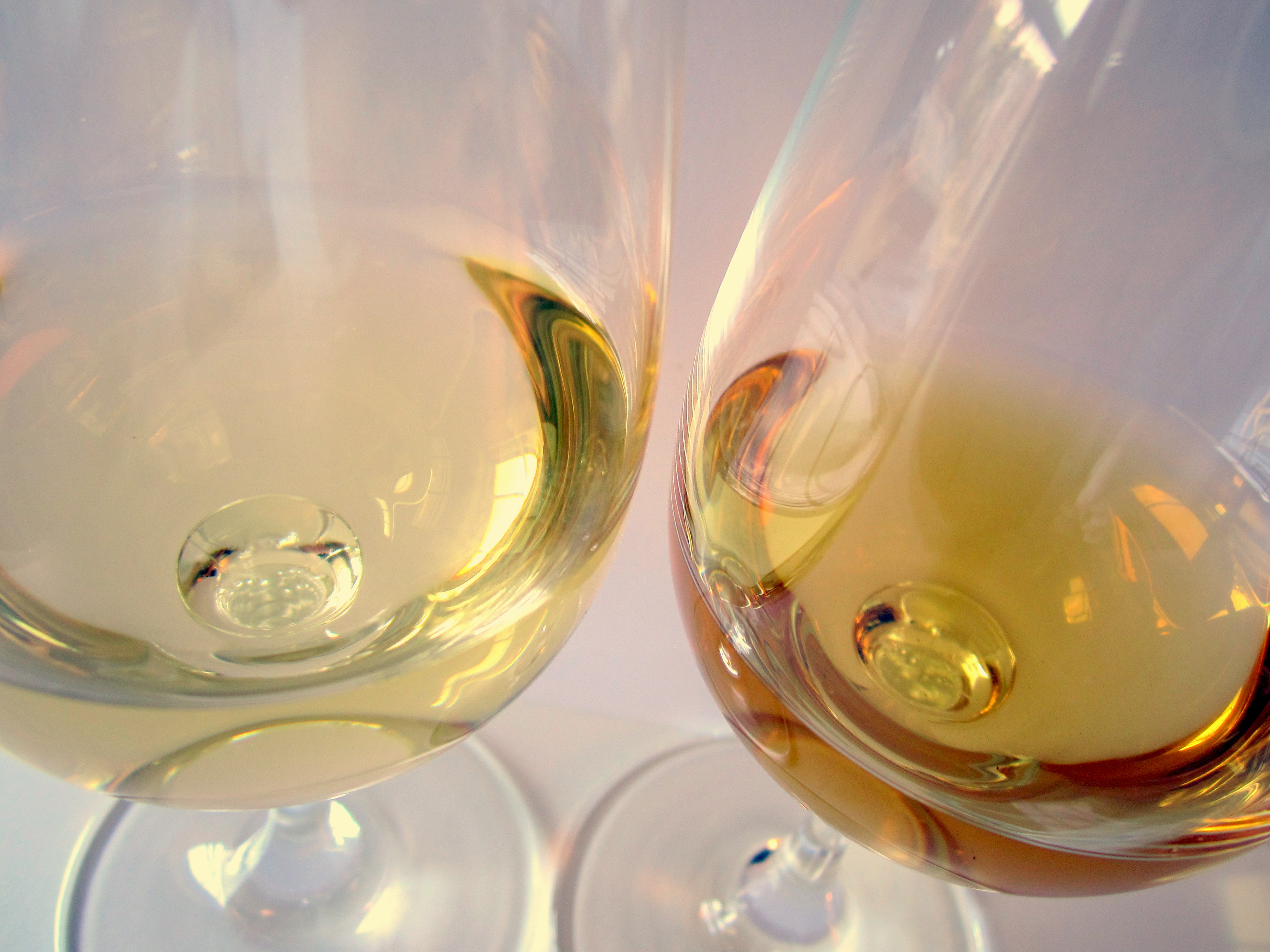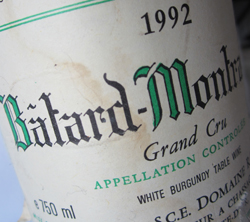
LAST WEEK A FRIEND showed up with a bottle of 20 year-old grand cru white Burgundy that for some reason had rather fully oxidized despite having been kept in a wine-friendly environment. A spongy cork made us think the wine might have long since gone off, but the opposite proved to be the case.
The color (deep amber), aromas (sherry-like), and flavors (fruit distinctly in the background) immediately reminded us of some orange wines we tasted recently, and pushed an intriguing question into the foreground: what is the difference, if any, between white wine that’s been intentionally oranged and a bottle that’s just plain over the hill – what we might call an accidental orange?
[If the orange wine category is new to you, see our earlier post on the topic here]
The answer: not all that much. The top photo shows a glass of the 2010 Monastero Suore Cistercensi “Coenobium” on the left, our overly evolved 1992 Domaine Ramonet Bâtard-Montrachet on the right. The Coenobium is made in a lightly oxidized style with something like a week of maceration on the skins (it’s a blend of trebbiano, malvasia, verdicchio, and grechetto).
It shows some of the added texture and nuttiness that comes from white wine made in the presence of oxygen. Our Bâtard has far more of both, along with more depth of color and features that one associates with bottle age (wines like this are often described as ‘sherried’ or Madeirized’).  One point of difference: As an accidental orange, Bâtard was never meant to oxydize in the way it eventually did and it wasn’t treated to the lengthy maceration on the skins orange wines typically receive.
One point of difference: As an accidental orange, Bâtard was never meant to oxydize in the way it eventually did and it wasn’t treated to the lengthy maceration on the skins orange wines typically receive.
Another point of distinction is apparent in the quality of the fruit. Our grand cru, despite its advanced development, still rings with firm (if rather dry) chardonnay fruit and nicely brisk acidity – a vibrant and engaging wine despite being so long in the tooth. We wouldn’t expect the Coenobium to age as gracefully, but then it presumably has less far to travel along the road to senility.
As to whether a stage that’s more or less undistinguishable from intentional orange is a stop every white wine makes along the way to complete undrinkability (if it lasts that long), or whether it’s a condition some skip entirely, we really can’t say.
A third distinguishing mark may be the most obvious one: you can’t just order up a bottle of old, Madeirized white wine in a retail shop, bar, or resto as you can one of the trendy new “rusty whites,” as they are sometimes called — and really, it’s a pity. A comparative tasting between wine made orange on purpose and those made orange by accident is fun to experience and interesting to contemplate, but hard to arrange.

But hold on. What if all those people holding old, heavily-oxidized whites in their cellars which they have no intention of drinking, can’t auction, and are too attached to to just throw out had an outlet for them similar to those trendy second-hand shops that specialize in high-priced, beat-up old jeans? Certainly tattered jeans and over-the-hill wine have a lot in common: each is ravaged by time; each has lived long enough to see geriatric versions of themselves become fresh objects of hipster envy.
I can’t say whether the idea would ever catch on, but if it does I’ll be ready. Just look for the sign that reads: The Worn-out Wine Boutique – Everything Shabby but the Prices.
That’ll be be my place.
Notes on three orange wines tasted last week.
2005 Radikon “Oslavye” Oslavia (Italy) Limpid amber hue reminiscent of Darjeeling tea; moderately forward aromas of dry, lightly figgy fruit with caramel and orange peel elements; complex, mature, and closely integrated. Palate quite clean and fresh with soil and fermentation aspects in the foreground, fruit behind. Feels grippy-dry with very firm acidity. Plenty of body here, but sits lightly on the tongue. Long, lingering, dry finish. 30% pinot grigio, 40% chardonnay, 30% sauvignon blanc. Natural yeasts; no sulfur added at any stage. Vinified and aged in barrel. Oslavye is a wine region in southeastern Friuli Venezia-Giulia. $28/500ml
2005 Vodopivec Carso Vitovska (Italy) Limpid deep gold- medium amber hue; aromas at first subdued but develop; a subtle candied note apparent; alcohol presents a little forcefully. Palate shows firm high-toned fruit, dry and grippy; adequate acidity and good lift. Bit more nutty and sherry-like than Radikon, but seems to lack the same persistent finish. Vinified in amphora, aged in barrel. Carso is a wine region in southeastern Friuli Venezia-Giulia; vitovska (100%) the grape variety. $66/750ml
2004 Gravner Oslavia Ribolla Gialla (Italy) Deep gold hue; perfectly clear and bright; aroma profile quite subdued and not obviously complex; palate dominated by brown apple fruit; some hard-to-pin-down punky elements add complexity and interest but don’t deliver much in the way of pleasure. Not a lot here to engage the hedonist, but from an intellectual perspective there’s plenty to savor. In our taxonomy of winemaker personalities Gravner is an idealist — a craftsman making museum-quality wine to a vision that’s his alone. Vinified and aged in amphora. $132/750ml
Reach me at stephenmeuse@icloud.com
Follow @stephen_meuse